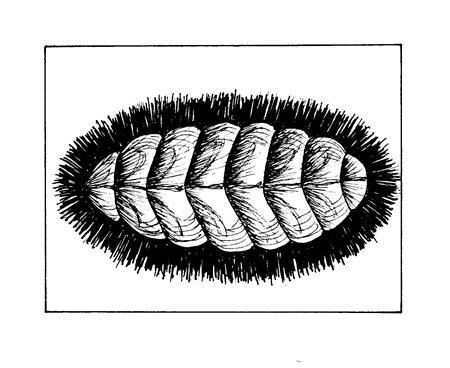Prehistoric Creatures Close-up

Chitonsare primitive marine mollusks resembling trilobites whose fossil record can be traced back to the Devonian Period over 400 million years ago. There are over 900 existing species and fossil records for over 400 more extinct species. They have a worldwide distribution and can be found from the rocks in the intertidal zone to a depth of over 10,000 feet. One of the most commonly found chitons seen in Laguna Beach is the mossy chiton (Mopalia muscosa). Tolerating a variety of environmental conditions, it has a range from Alaska to Baja California both in the ocean and in brackish estuaries. Locally, this species can be found exposed in the tidepools attached to the top or sides of rocks between the mid to low tidal zone in areas protected from heavy waves and often camouflaged in its surroundings.
Oval in shape and flattened with an elevated center ridge, the mossy chiton can reach a maximum of 3.5 inches in length but in Laguna, are usually one to two inches long. Their exterior is made up of eight overlapping plates, which after death, separate into small butterfly shaped, opalescent shells that may be found in tidepool debris. While alive, the plates of the chiton are held together by a girdle of tough tissue covered with stiff brown bristles that give it a mossy appearance. The bristles aid in defense and possibly act as a sensory organ. Dully colored in shades of black, olive and brown, the plates may be mottled and eroded by wave action or encrusted with algae and marine organisms. On the underside of the gastropod is a broad, muscular foot, which is used for locomotion and to adhere firmly to the hard substrate. The mantle cavity containing the gills forms a ring around the foot and is used for excretion.

Primarily herbivores, the head is at the front of the foot and has a mouth that contains a radula (rasping tongue). It is reinforced with magnetite, an iron mineral that is used to scrape green and red algal film off the rocks. Like some limpets, the mossy chiton spends the day in a depression in the rock called a “home scar” that is sized just large enough to hold it. At night or when submerged with water, it emerges to feed, maintaining a grazing territory of approximately two feet. Territories of individual chitons tend not to overlap. When daylight appears or the tide recedes, it returns to its home scar to await the next cycle.
The mossy chiton is dioecious, meaning the sexes are separate. Broadcast spawners, they release brown or greenish eggs, which hatch in the water into larvae. For almost two weeks, the larvae swim freely until they settle on the rocks and develop into juvenile chitons. Predators include ochre seastars which pry them from the rocks and marine birds, in particular, glaucous-winged gulls and black oystercatchers. There is also some historical evidence that they were harvested by Native Americans, who lived at the coast but there is no current fishery for the species.
Artist Jan Sattler and Mia Davidson are residents of Laguna Beach and year-round ocean swimmers who want to remind you that Laguna Beach is a state marine reserve, where collecting or fishing is forbidden.





[…] Source […]